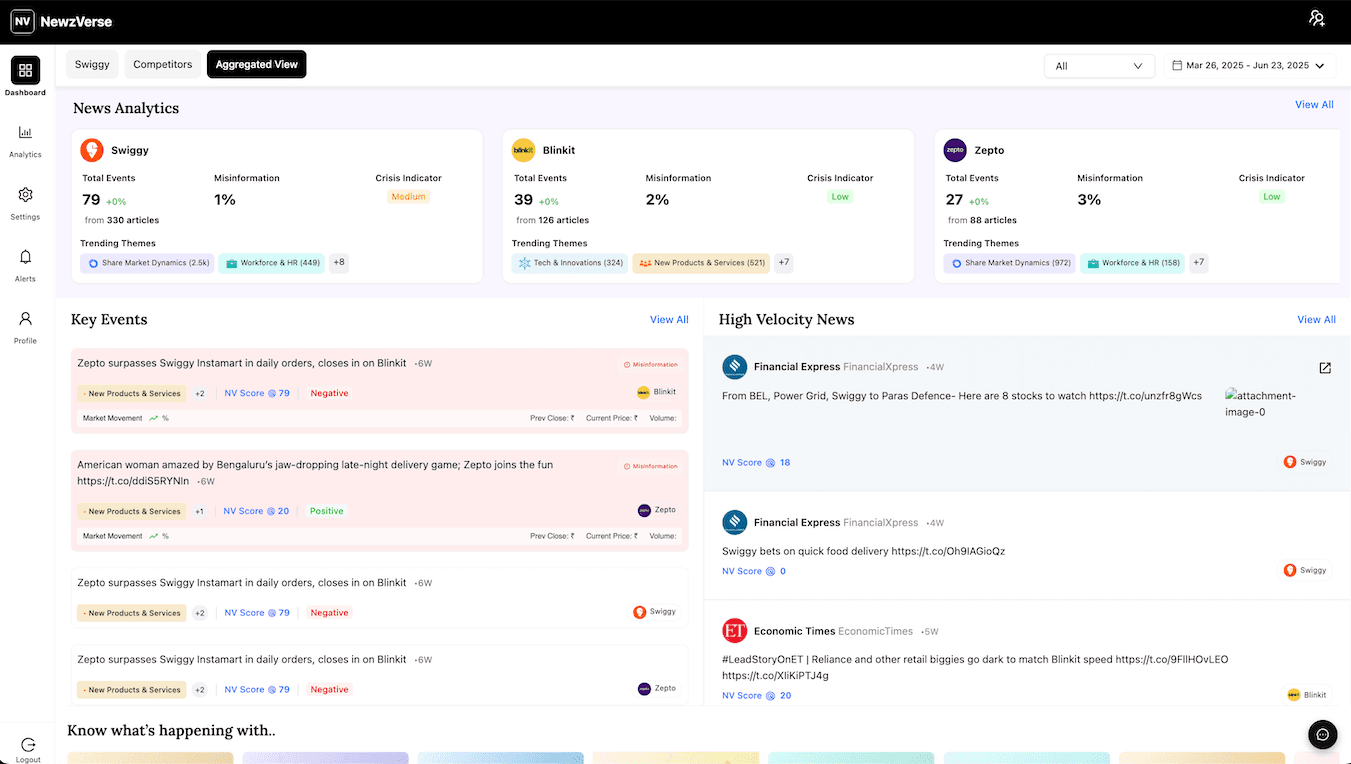UX Strategy ForAI-Powered MediaIntelligence

Role
Product Strategist, UX Designer, Design QA
Timeline
6 months | Feb 2024 - July 2024
Team
1 PM, 7 Developers, 1 Designer
Platform
Web app (B2B SaaS)
Context
Today's business landscape demands more than just news monitoring - it calls for real-time media intelligence tailored to the companies that matter to you . This platform was designed to help teams track high-velocity events - not only from top-tier news outlets, but also from X (Twitter) and LinkedIn posts by key people in your selected companies.
Whether you're in compliance, strategy, or PR, the goal is simple: surface what's relevant, filter the noise, and enable confident, fast decision-making.
Problem Statement
Existing tools lacked accurate detection of misinformation, which directly impacted the reputation of companies.
When false news spread, it often led to market volatility and loss of stakeholder trust. SEBI (Securities Exchange board of India) introduced a regulation mandating companies to report any such misinformation promptly to help control its impact on share prices.
Design Process
Discovery & Problem Framing
Persona Definition
Lo-Fi Wireframing
Hi-Fi Mockups & Design System
Interactive Prototypes
Usability Testing
User Personas
Understanding our target audience was crucial in the design process. Here are our Personas with their goals.

PR & Corporate Communications Lead
Monitor media coverage volume
Track misinformation mentions
Analyze brand sentiment trends
Follow key journalist coverage

Investor Relations / Risk Analyst
Monitor stock-media impact
Identify crisis triggers
Track media tone on market dips
Prepare investor communication

Brand & Marketing Manager
Track campaign traction
Analyze theme ownership
Benchmark marketing buzz
Follow key journalist coverage

Compliance & Regulatory Officer
Monitor fraud/breach flags
Detect misinformation risk
Assess compliance signals
Key UX Solutions
Misinformation Detection Interface
Problem:
Users couldn't easily differentiate credible vs. misleading news, leading to delayed action and risk exposure.
Solution:
Designed an interface that flags potential misinformation using contextual explanations and contradiction cues. Users can quickly understand why a claim may be inaccurate through clear reasoning - enabling faster, more confident decisions.
Alert Trigger System
Problem:
Most teams react to misinformation after the damage is done - by then, share prices drop, media pressure builds, or SEBI scrutiny begins. While alert systems exist in other tools, they typically follow rigid, linear workflows, limiting how teams can adapt to the fast, chaotic nature of misinformation spread.
Solution:
Designed a modular alert builder that mirrors how real signals behave — by grouping conditions into Time, Volume, and Event Attributes. This flexible logic system enables teams to define what "risk momentum" looks like for them (e.g., 5 negative posts about frauds within 15 minutes), so they can act before an issue escalates. The result: a shift from reactive monitoring to proactive signal-driven intervention - built for high-stakes communication.
Share Market Impact
Problem:
Most teams monitor media sentiment, but they lack visibility into its probable effect on share prices. This gap makes it hard to judge whether a spike in news is just noise - or something that's genuinely moving the market. Without this correlation, teams either overreact or miss critical moments.
Solution:
We enabled teams to see live share price and volume movements as an event unfolds, so they can instantly assess market sensitivity. This helps differentiate real threats from noise, making interventions more timely and evidence-backed. It also supports compliance teams in aligning with SEBI's mandate to report misinformation that affects investor sentiment or share prices.
NV Score Visualization
Problem:
With high volumes of news and posts, teams struggled to distinguish which events needed urgent attention - often reacting to noise instead of signal.
Solution:
Enhanced and visualized the in-house proprietary NV Score developed by Locobuzz - a dynamic metric that evaluates each news event based on multiple attributes like source type, sentiment, velocity, credibility, and business relevance. All key events are sorted using NV Score, giving users an immediate understanding of impact, and helping them respond to the most critical developments first.
Theme Categorization
Problem:
Users felt overwhelmed by unstructured feeds of news and posts.
Solution:
Introduced Insight Themes - a set of 10 key categories that every signal is sorted into, like PR Watch, Compliance View, and Leadership Movement. Each theme contains events, and each event contains the related articles or posts, helping users see the bigger picture at a glance. This layered setup turns a noisy feed into a clear, organized view of what's unfolding and why it matters.
Outcomes
• Enabled faster detection and internal escalation of misinformation events within minutes
• Supported SEBI compliance by streamlining structured alert creation and reporting
• Improved cross-functional coordination between PR, Compliance, and CXOs
• Internal testing showed 94% success rate in alert setup for misinformation events
Key Learning
• Designing for multiple personas requires strict information hierarchy
• Complex AI outputs need transparent, explainable UI layers
• Testing early helped reduce rework and align teams faster